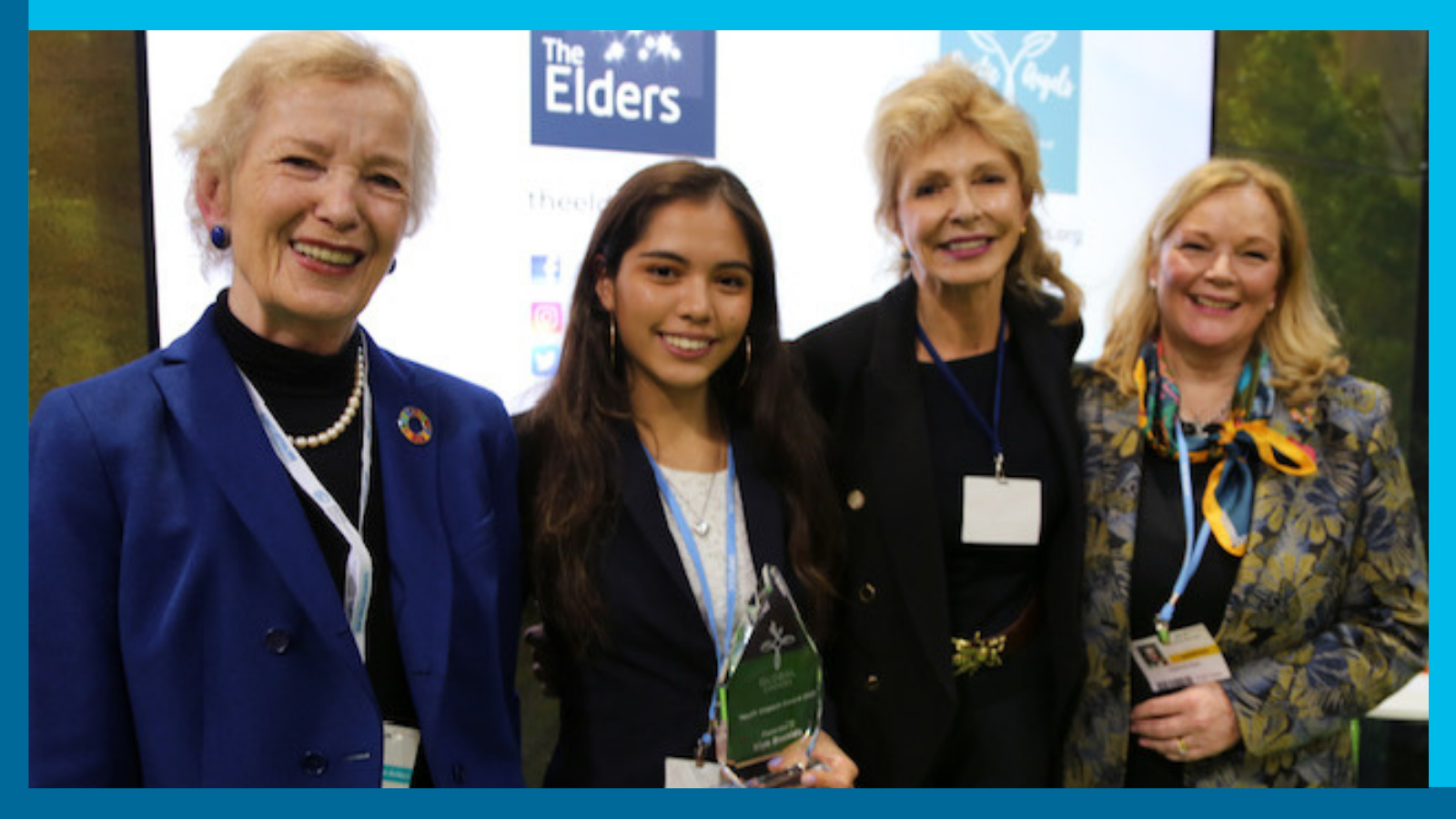In honor of International Women’s Month, The Planetary Press is highlighting women around the globe who are driving positive change for our planet and global community. Today, we are thrilled to introduce you to Co-Founder and Executive Director of Global Choices, Inge Relph.
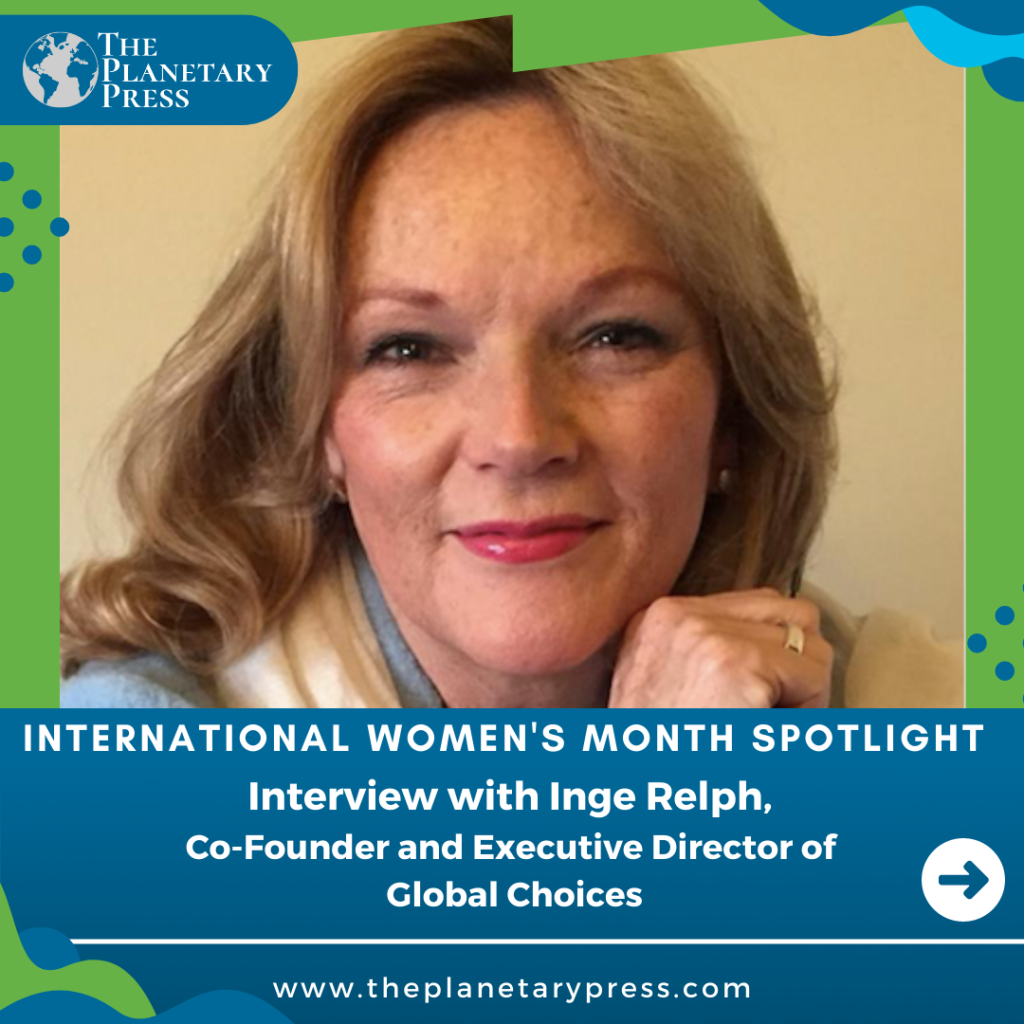
You have a remarkable career, from working with corporations to serving as a Senior Policy Advisor to The Elders to advising the Vatican on climate, social justice, and peacebuilding. Please tell us more about your background and how you first got involved in the climate space.
You could say it was in my genes! My childhood was spent immersed in the beauty of nature in South Africa. Having liberal parents (a Danish mother and an English father), social justice was always a dinner topic. This was strengthened by marrying a nature-loving, faith-motivated activist in my teens. Together, we were big supporters of the anti-apartheid movement, eventually leaving South Africa in protest.
My early career in the UK was corporate strategy and restructuring large energy companies, which was put to good use when I did some pro-bono restructuring of WomanKind Worldwide, a large not-for-profit organization focused on global women’s rights. This opened my eyes to the agency of women, especially in least developed economies, and the crossover benefits to be had when businesses and not-for-profits collaborate.
Although I loved the corporate arena, where I was enjoying some success, I felt I could be of more benefit by more directly impacting lives, especially the lives of women disproportionately affected by conflict. There ensued all sorts of global adventures, from helping to conceive and set up the Elders with a dear friend Scilla Elworthy, designed to harness the wisdom and experience of retired Statesmen and women, to working in Egypt establishing the first Middle East peace movement centered on the nexus of development, diplomacy and training women as peace negotiators.
At the time, so few women were included in vital peace talks where constitutions and, therefore, their futures were being decided. Spending time on the ground supporting women through the conflicts in Libya, Syria, Iraq, Somalia, and elsewhere was sobering, experiencing firsthand the senseless human impacts of conflict – something we are starkly reminded of with the Ukraine war. It was utterly inspiring to work with so many women— and men too— many with minimal resources who were willing to put self-interest aside to try and secure a better outcome for the common good. I was deeply affected by seeing the destruction of nature, the intergenerational legacy of trauma carried by displaced communities, and the fragility of subsistence living. It was obvious to me that climate impacts would exacerbate conflict through food insecurity and more people on the move.
Seeing things with a strategic lens led me to rethink how we, as a global community, can be more effective at working with root causes and get better at preventing harm. The saying “when the pupil is ready, the teacher appears” manifested for me as the intersectionality of climate and development and conflict resolution was largely the mission of The Elders with whom I had the privilege to work, helping to get the landmark Sustainable Development Goals (SDGs) and the Paris Climate Agreement over the line. The Paris meeting highlighted how far and fast we need to decarbonize to keep our planet viable. This has become ever more urgent as we are now at record levels of global heating.
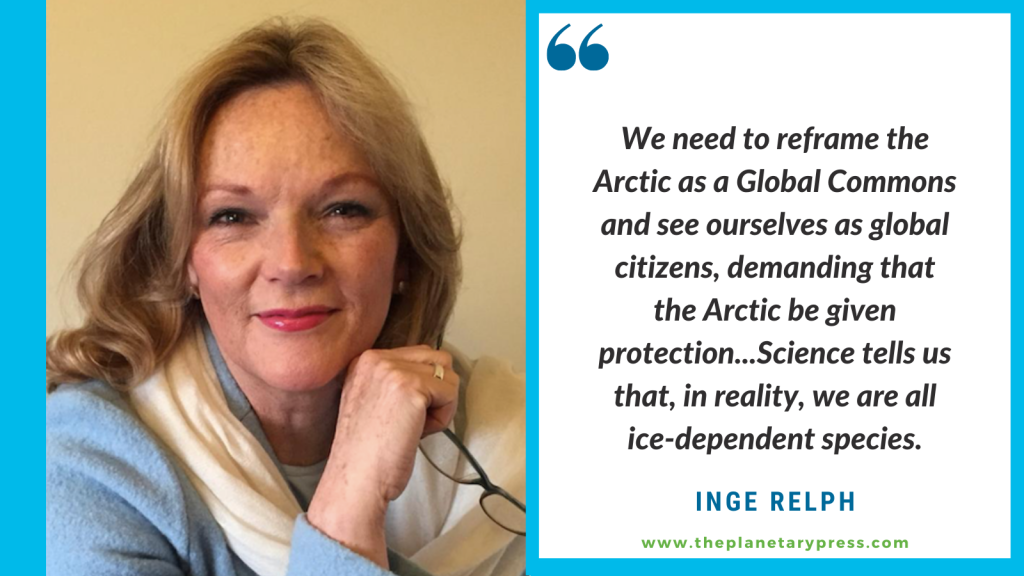
Since the 2015 Paris Agreement, there has been an encouraging uptick in climate awareness and action— trees planted, plastics being recycled, tech solutions, etc. Yet my Co-Founder Sally and I saw a big gap in the prioritization of action. We are largely missing the protection of the most urgent piece of the climate puzzle— the Arctic! It is the apex of our climate systems, and not only is it our planetary cooling system shielding us from solar radiation, but it is also the main regulator of our climate.
The Poles are warming four times faster than anywhere else on the planet, and our polar ice shields are headed for extinction on our watch. This will mean unprecedented changes to ocean and atmospheric currents, destabilized weather patterns, and biodiversity loss. As the oceans warm, the Greenland ice sheet and Antarctic ice loss could see sea levels rise up to 20ft, threatening coastal communities globally. The aha moment for me was that it is irrecoverable. Once lost, it’s pretty much gone in our lifetime. Our strapline is “You can’t plant Ice.”
Can you tell us about your mission with Global Choices?
With more and more scientific evidence linking the loss of Arctic sea ice to the extreme weather events we are now encountering globally, our mission is to drive action on the ice crisis, prioritizing the protection of the Central Arctic Ocean Ice Shield.
The way we are doing that is multipronged. We are calling on policymakers to urgently step up and safeguard what we can of the remaining Central Arctic Sea Ice, which is High Seas, also called an area beyond national jurisdiction – i.e., not belonging to one country but a system that serves all of us.
- We are calling for a 10-year moratorium, a precautionary principle pause that will not allow proposed deep-sea mining, oil and gas extraction, transpolar shipping routes, radioactive waste dumping, or nuclear weapons testing. To the great consternation of scientists and conservationists, commercial and State interests are hovering to take advantage of exposed riches as the ice melts. We say “hands off!” as we know more about the moon than life under the ice. We do know that there are over 21,000 unique Arctic species, part of a complex, interconnected food chain under threat, and that exploitation like oil and gas drilling and deep sea mining in such a fragile, pristine part of the globe should not be sanctioned.
- We need to reframe the Arctic as a Global Commons and see ourselves as global citizens, demanding that the Arctic be given protection given that, yes, the livelihoods of Arctic Indigenous Sami families will be affected, but Samoans and low-lying islands will be underwater. Science tells us that, in reality, we are all ice-dependent species.
- The Arctic is a very visible barometer of emissions. For every ton of CO2 emitted, we lose three meters squared (32ft squared of ice). A flight from New York to London uses approximately half a ton of carbon, so seeing the correlation can be a huge incentive to cut emissions to keep under 1.5 degrees Celsius. We need as much innovation in climate policy and process as we do in climate tech, so do see more about our Arctic Legal Defence Fund and finance and risk models on our website.
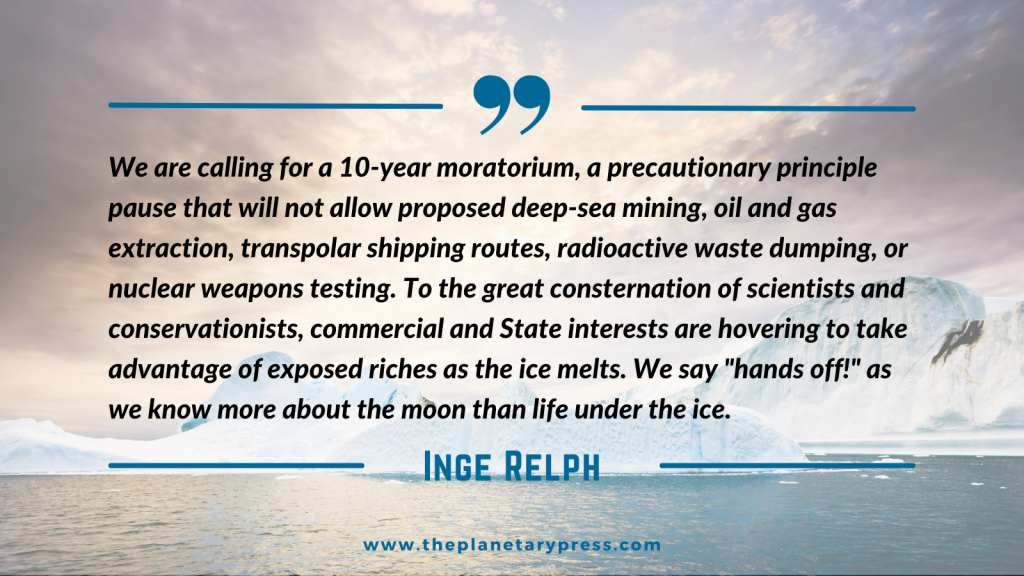
Women’s empowerment is at the heart of what you do at Global Choices. Can you tell us about your Arctic Angels program and how the Arctic Angels are driving change?
Agreeing with the Pulitzer-winning authors of The Athena Doctrine that “The feminine is the operating system of the 21st Century,” we are an all-female-led nonprofit organization with feminine leadership core to our operating ethos. The feminine, present in both men and women, tends to see the whole and is a way of being that is willing to set self aside for the common good.
Understanding the power of the feminine and the rise of youth activism, we combined these to build a powerful global community of over 57 highly skilled young women climate activists aged between 13 and 35 from over 35 countries who speak up for Arctic protection. With wisdom beyond their years, the Arctic Angels are willing to stand up and fight to protect our common home. Perhaps most importantly, we have cultivated a safe space of support and encouragement where they learn from one another, a network of networks. We mentor them, provide leadership training, and enable their voices to be heard on platforms they would otherwise struggle to access.
An example is a recent event at COP26 in Egypt with H.S.H. Prince Albert of Monaco, Johan Rockström, the world-renowned climate scientist, and Dr. Sylvia Earle, the luminary oceanographer with Shreya, a young Arctic Angel from Nepal, being given equal billing and telling of her firsthand experience of the floods from the melting glaciers of the Himalayas and her activism there to champion the protection of the cryosphere.
It is vital that the perspectives of the generations most affected by climate change are taken into account and that they are given the tools they need to become compassionate and thoughtful leaders for a more balanced, sustainable, and just future. I can honestly say that if I am having a down day, spending time with them is restorative, inspiring, and motivating.
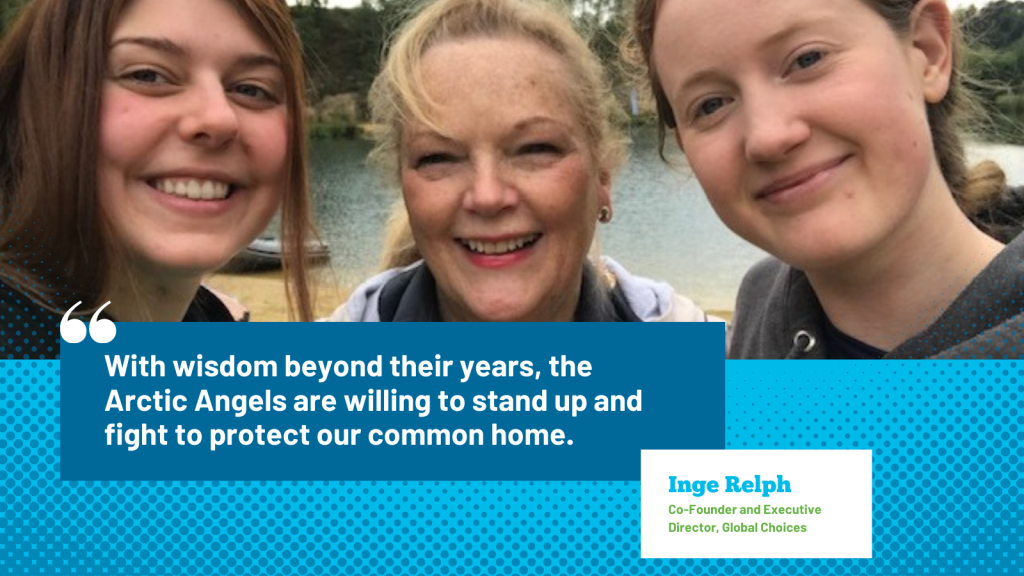
How can someone become an Arctic Angel?
There is an application form on our website. It is highly selective with an interview process, but we are delighted to hear from young leaders and especially keen to have more Indigenous and Asian voices. We are also building the Arctic Ice Force, which is open to all. Our youngest Ice Defender is three months old, and the oldest is 83! Please do add your voice – it is simply an email signup on the website and help us protect the Arctic Ice Shield.
Now more than ever before, we are seeing youth call for ambitious climate action and change. What role can youth play in informing policy change and innovation on environmental issues?
As we have seen when watching Greta Thunberg and others in action, the mobilization of youth voices has and is having a significant impact on policymakers in a number of ways. I heard John Kerry, USA Secretary of State, say that many leaders are now more afraid of the youth lobby than of their own constituents— and I don’t think he was joking! They hold policymakers’ feet to the fire and call out hypocrisy. They know their stuff on climate and have a strong sense of justice and a nose for BS. Authenticity matters, as does evidence of action, be it in policy or on the ground. Fuelled by social media, they are so global in their reach.
With that said, we are strong advocates of intergenerational action as there is that saying, “the young can run fast, but the old may know the potholes on the way.” Experience does still count for something, even in a topsy-turvy world.
Whilst climate anxiety is very real, there is a bit of me that is envious of coming generations because they will enjoy a better world with cleaner air and oceans, purpose-driven jobs, and be part of an incredible renaissance of innovation given that many of the solutions that are needed haven’t even been created yet. So terrific opportunities lie ahead— provided, of course, we make the right global choices now that will shape this better future.
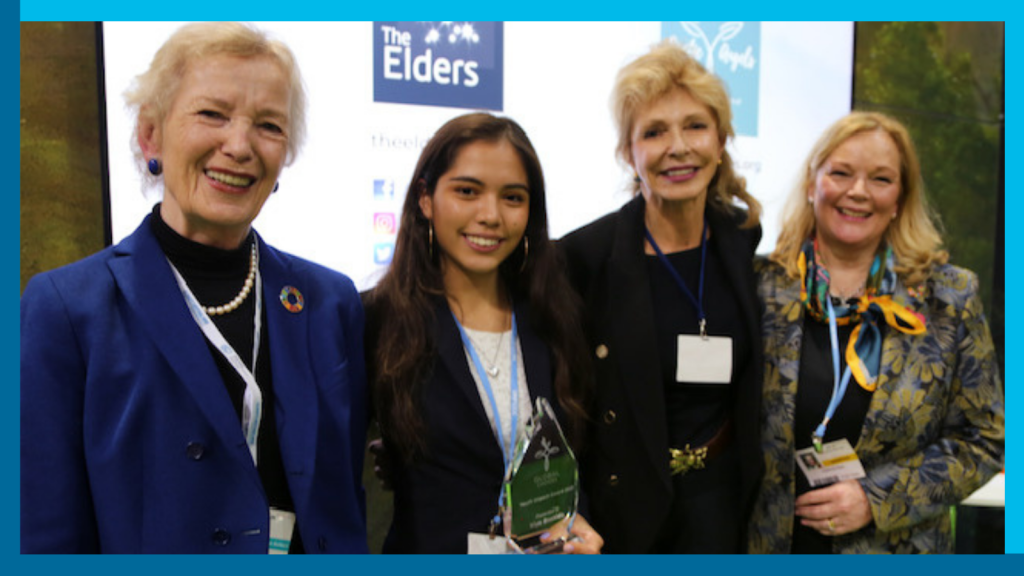
How can female leadership lead to stronger, more ambitious climate action?
We prefer to say feminine leadership embodied in women especially, but not to exclude men. Yes, we saw how influential strong female leadership under Christiana Figueras was in getting the Paris Agreement across the line. Why? Simply because of less ego posturing, a tendency for more consultation, greater compassion, empathy, and, what is now clearly a strong intergenerational aptitude, willingness to collaborate. There is greater self-awareness among women and the humility to change, which is harder for men because of the way our societies have driven them to see success achieved at the cost of others and to see introspection as “weak.” The Greek philosopher Plutarch understood the importance of self-awareness when he wrote, “what we achieve inwardly will change outer reality.”
How can finance be a tool to combat the climate crisis?
Without efficiently deployed and equitably distributed finance, we have little chance of implementing climate mitigation, adaptation, and innovation for a sustainable future. An estimated $100 billion per annum needs to be mobilized, and whilst multilateral climate financing has increased significantly, there remains a large funding gap.
Financing trips up most international agreement negotiations where climate justice voices call for the polluting countries to pay for the investments needed to protect countries that are the lowest polluters but most impacted, such as the Pacific Island States. Thankfully the ethics of creating funds for this is becoming undeniable and has underpinned some recent global agreements like the Convention of Biodiversity agreed upon in Montreal last year.
Changes in the financial system itself are happening where investors and shareholders, sometimes nudged by regulation, are demanding that their funding has a nature positive and zero carbon impact, which increases the money flow to projects on the ground. Innovation in finance as a tool is happening to scale with reimagined instruments such as nature performance bonds, blue bonds for ocean conservation, and underwriting of corporate capital to encourage innovation and investment for small-scale projects like insurance for domestic fishermen.
There is a big push globally to incubate and incentivize new enterprises to tackle climate issues, such as re-growing coral and producing new forms of biofuel with zero carbon emissions. Despite female entrepreneurs producing better returns, inequity remains in the amount of venture capital and seed capital women-led enterprises attract, and it is a matter of social justice and climate-smart strategy to change that.
Carbon is relatively easy to price and trade, but more challenging is how we value nature and her ecosystem services as well as the associated human impacts. The recent work by Professor Partha Dasgupta and his team has helped us understand that biodiverse nature underpins and sustains economies, livelihoods, and well-being, and therefore investing in nature is not a “nice to” but a must-do.
What message do you have for today’s youth who want to take action on protecting the Arctic and its biodiversity?
Firstly, know your voice matters. Join a network, sign up to the Arctic Ice Force as an Arctic Ice Defender, get your mates to do the same, get informed, and share your knowledge at school, college, work, or around the dinner table with family and friends. Donate, even small amounts help, and sign up for an app that helps you watch your personal carbon footprint as we all need to cut our consumption. Imagine the world you want and the world you want for generations to come.
What do you see as the biggest challenge facing our global community? Given your expertise, how can we solve it?
Without question, the degradation of our planet, the increasing weather extremes and unreliability of climate patterns, and the consequent destabilizing impacts on people and geopolitics as large numbers of people get on the move. We already have more climate refugees than refugees from conflict. Couple that with the current breakdown in multilateralism, and we have a huge challenge. However, I agree with Al Gore – it’s a “moral opportunity.” It can also be the solution to the breakdown of multilateralism because nature will, by hook or by crook, force us to collaborate to survive.
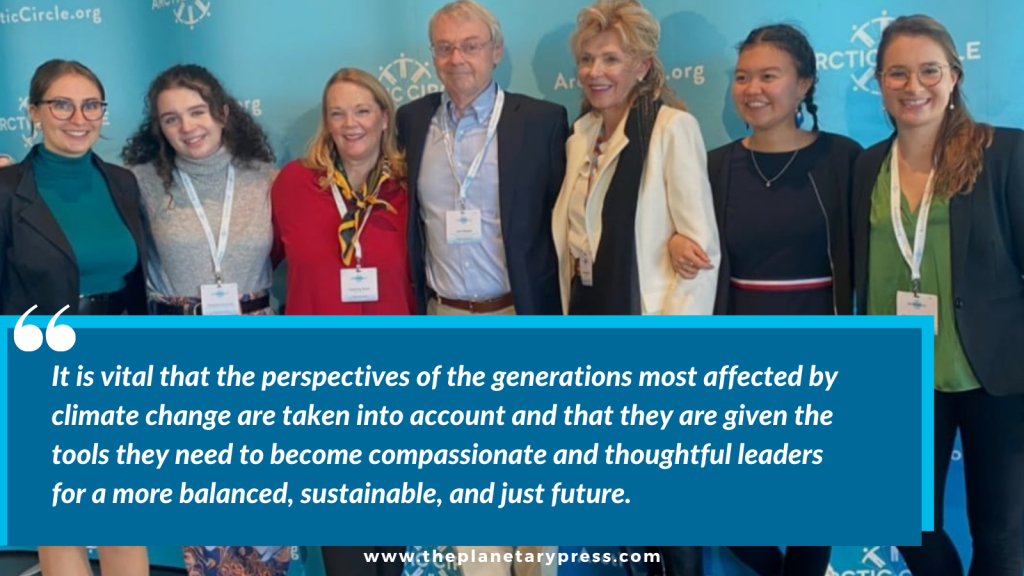
What are your three favorite solutions to one of the world’s challenges?
Ultimately for me, it comes down to understanding that the problems come from separation from ourselves, separation from one another, and separation from this one little planet that nurtures us. My favorite solution is the consciousness that we are One Humanity, dependent on the Global Commons, these interdependent natural systems crucial to all life. Also, the recognition that there is no such thing as “away.” Thirdly, there is no such thing as an “other.” If I harm you or nature, I harm myself.
What new innovations or technologies are you most excited about?
Very exciting and still in early stage development are new forms of abundant zero carbon energy like fusion. I also love the idea that most of the technologies that will dominate our future haven’t been invented yet so current and future generations will have the opportunity to create these game changers, much in the way the internet changed everything.
What are some of the challenges you have faced along the way, and how have you overcome them?
Gosh, there are so many! Anticipating things too far ahead of time for people to grasp the relevance – e.g., we were early on warning of the impact of Arctic Sea Ice loss, but it has taken a while to get the criticality across. The passing time and evidence of extreme weather, along with getting better at storytelling, is overcoming indifference.
As a not-for-profit organization, especially one seeking to make precedent-changing policy, fundraising is an ever-present challenge, and despite being innovative and excellent at execution, it is a continuous challenge that we constantly need to overcome.
Another is sometimes becoming overwhelmed by the crushing enormity of global problems. The remedy I have found is to surround yourself with a community of support and encouragers (women are especially good at this) and to tackle the challenges systematically in deliverable chunks. Getting out into nature to recover the awe of how beautifully things work without us sort of “right sizes” the problem. Telling myself that things don’t last forever and that everything can change, including me. Seeking out things that inspire me, such as a poem like this, generally does the trick:
And while I stood there I saw more than I can tell and I understood more than I saw, for I was seeing in a sacred manner the shapes of all things in the spirit and the shape of all shapes as they must all live together as one being - Black Elk
What advice would you have for your 13-year-old self?
Go for it. Do your best and risk failing. Seek out wisdom above knowledge. Be authentic and kind, and pay attention to developing your inner world as well as the outer one. Lastly, never stop learning and laughing— and don’t pluck your eyebrows.
What book would you recommend to inspire people?
That’s not a fair question for the daughter of a librarian!
“The Future We Choose” by my friend Christiana Figueras and Tom Rivett- Carnac because they have been in the trenches and seen the other shore.
“Spiritual Ecology” – a collection of inspirational essays; edited by Llewellyn Vaughan-Lee
“Three Horizons – The Patterning of Hope” by Bill Sharpe inspires a new way of thinking that can tackle complexity and find ways to realize our hopes for a better future.
“Braiding Sweetgrass” by Robin Wall Kimmerer is mesmerizing Indigenous wisdom that inspired me to look differently at nature.
Last but not least, any of A.A Milnes’ Winnie the Pooh books, partly because I married a Christopher Robin! That indomitable optimism and the collective support of Pooh’s friends saw them bounce and tiddly-om-pom their way through every situation. They continue to do so, inspiring generations to come.
Keep up with Inge, Global Choices, and the Arctic Angels!
Website: www.globalchoices.org
Twitter: @GCArcticAngels
Facebook: @GlobalChoicesOrg
Instagram: @gcarcticangels
LinkedIn: @Global Choices

